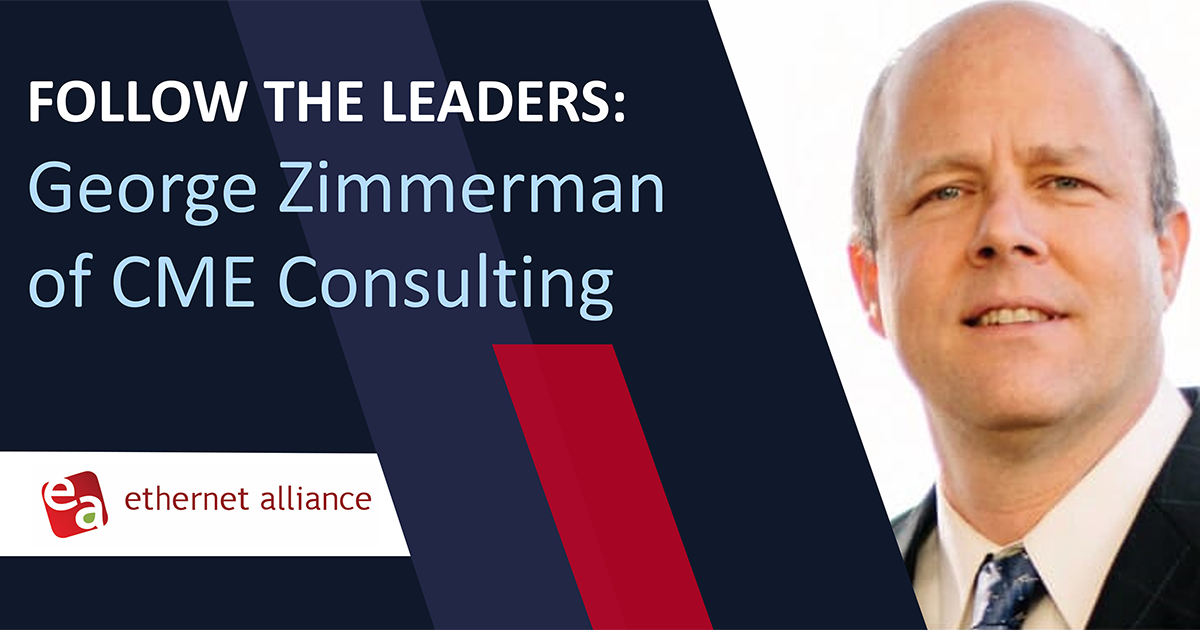Dan Dove, Ethernet Alliance Board Member
An Ethernet Alliance Board of Directors member, Dan is currently serving his second term as the Technical Chair of the Ethernet Alliance’s High-Speed Ethernet (HSE) Subcommittee. He also has served as chairman of the IEEE’s Next-Generation 40G/100G Optical Ethernet study group since July 2011.
He enjoys participating in the Ethernet Alliance because he likes being engaged with its many members who are recognized as influential people within the industry. When communicating with the Ethernet Alliance’s high-caliber membership, ideas come to the surface that can be further developed by collaborating with those same people.
Why should companies become a member of the Ethernet Alliance?
The Ethernet Alliance is a great organization for companies that want to get more connected with the rest of the industry and understand the opportunities available in the Ethernet market. It’s also great for those that have a concept for a standard they would like to advance with fellow industry members before taking it into an IEEE group to promote.
If you look at our membership roster, it’s a real “Who’s Who” of major contributors within the Ethernet industry, many of whom hold significant influence within the standards bodies. Therefore, our members have the opportunity to engage with people who can make things happen.
Our members also have opportunities to assist the rest of the industry. People with new ideas that they believe need to be pushed harder will find support for consensus-building within the Ethernet Alliance. We can help you get your idea vetted, modified, or enhanced with other members’ help. And when it gets to a point where there is true value to the industry, the Ethernet Alliance can help build consensus to drive that idea forward.
The Ethernet Alliance’s subcommittee structure is focused on defined areas of technology. For example, the High Speed Etherent (HSE) Subcommittee has a charter and some specifics focused on HSE 40G/100G. As an example; If someone wanted to develop a 40G extended reach optical solution, they would likely run into like-minded people. Together, they could potentially build enough consensus to move into the IEEE with a call for interest (CFI) and build a standard.
So, this subcommittee structure plays a big role?
That’s where all the action really happens. As a member of the board, I can tell you that we want to see action taking place in our nine existing subcommittees. You could even propose a new subcommittee if it made sense – for example, the HSE subcommittee is considering changing its name to the 40G/100G Ethernet subcommittee to focus on these technologies and leave the door open for the formation of a new HSE committee aimed at even higher speed Ethernet solutions.
How does the Ethernet Alliance help to expand the Ethernet ecosystem?
As they mature, the subcommittees help to expand the Ethernet ecosystem. They often start out in the consensus-building stage, trying to get a standard developed, and getting objectives or baseline proposals adopted by the IEEE. Once that happens, the subcommittee evolves into a marketing organization by helping to increase awareness, performing plug fests, and creating a landing zone for real products. When the technology becomes available, customers know how to deploy it, where to get it, and what to expect from it.
Another key item we provide is education in the form of white papers, blog posts, social media messages, conferences, and webinars. Education is needed because the food chain for technology evolution tends to start at the supplier end. They put together new technologies and move them towards standardization, and that is when system vendors and end users typically get involved.
End users provide direction on what they expect to get out of that technology when it becomes available. Because they have not been involved in the entire process, end users may not understand how the technology is going to manifest itself in the world. That is where the Ethernet Alliance comes in – we educate those end users.
Why is the Ethernet Alliance making a global push?
We all see the importance of expanding our vision to include other regions of the world, primarily because Ethernet plays a significant role all around the globe. Therefore, our membership should reflect that too. We’re also taking this into consideration in our educational efforts. If we only provide educational materials in English, that limits the breadth of our reach and global outreach. We need to educate and communicate with members from around the world in their native languages. We also need to participate in trade shows outside the U.S. and truly globalize our activities.
What is the challenge in going global right now?
It’s the classic chicken and egg scenario: in order to expand our educational efforts and communication outward, we are going to need people with language skills and cultural understanding of places outside the U.S. We’re currently expressing our desire to globalize, our need for people who have multicultural and multilingual experience, and are soliciting contributions from member companies with those capabilities. They can become leaders in their own geographical areas and help the Ethernet Alliance to achieve its global objectives.
What does the Ethernet Alliance do to ensure interoperability and why is it important?
Ethernet and interoperability are joined at the hip – Ethernet is famous for its inherent interoperability – which is one of the reasons that the technology is as successful as it is today. When Ethernet was first introduced, computers were communicating in many different ways. Everyone had their own way of doing things, and nothing talked to anything else.
The people who created the Ethernet specification wanted make it possible for everything to work the same way and communicate together. This was made possible by starting with a thorough technical specification that was designed by definition for interoperability.
Verifying and demonstrating interoperability is critical. The Ethernet Alliance’s interoperability plug fests validate that things work the way they are intended to work. Ultimately, this means that no matter where you go in the world, or whose Ethernet equipment you use, you can plug things together and it will work.
If Ethernet is so compatible, why do you need to verify interoperability?
Over time we have discovered that specifications sometimes have areas that are not fully defined or may be open to interpretation.
Plug fests provide system and component vendors with a high level of confidence in the interoperability of their equipment before it gets to the end user. A manufacturer might be building the first switch ever made for a new Ethernet technology. Someone else might be building equipment that connects to that switch. If the two pieces of equipment work together at the plug fest, we build confidence they will work in the field, too. If not, the member companies can turn to other Ethernet Alliance members to help identify and resolve the problem.
Companies can try to do this on their own, but a lot of times the equipment they need to plug into is still in the lab. They can achieve a certain level of interoperability, but our plug fests offer a much broader scope of testing. Furthermore, all plug fest participants are members of the Ethernet Alliance and thus recognize the importance of interoperability as a fundamental part of Ethernet.




